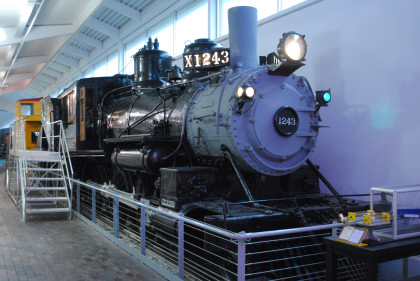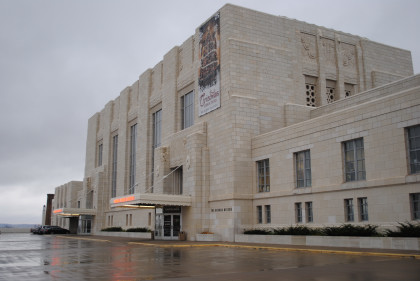
From Kennefick Park, my next stop was the Durham Museum and I parked in their parking lot.
Union Station, OmahaIn 1862, President Abraham Lincoln signed the Pacific Railway Act, creating the Union Pacific Railroad and fixing its eastern terminus at Council Bluffs, Iowa. The major goal of Union Pacific was to lay railroad tracks west to join up with the Central Pacific Railroad and complete the first railway from the Missouri River to the Pacific Ocean – the Transcontinental Railroad. Because there was no bridge across the Missouri at that time, construction started at 7th and Davenport Streets in Omaha and headed west.
Several railroad stations came and went in Omaha's early years. Construction of Union Station, which today houses The Durham Museum, commenced on July 29, 1929 on the site of the 1899 station. Rapidly increasing passenger rail traffic convinced Union Pacific of the need for a new building and it was decided a truly elegant and contemporary structure would best portray the image of the corporation. Gilbert Stanley Underwood, one of the finest architects in the classic art-deco style, was given free rein in designing the structure and his style is reflected in every facet of the construction. He utilized a terra cotta exterior overlay to create a visually stunning effect and was involved in all artistic decisions from the ceiling of the Main Waiting Room to the door handles on the ticket counter. Peter Kiewit Sons’ was commissioned to build Underwood’s steel framed structure.
After twenty months and $3.5 million, the 124,000 square-foot building was complete. The station opened to great fanfare on January 15, 1931 and quickly became one of the busiest stations in the nation. At its peak, 64 passenger trains and some 10,000 passengers utilized the facility every day. The focal point is the Main Waiting Room, currently the Suzanne and Walter Scott Great Hall. Measuring 160 feet by 72 feet, it is spanned by a 60 foot high ceiling. The Hall features a ceiling of sculptured plaster, with painted gold and silver leaf trim, ten cathedral-like plate glass windows, a patterned terrazzo floor, columnettes of blue Belgian marble, and a wainscoting of black Belgian marble. Six immense chandeliers, 13 feet tall, five feet in diameter, and suspended 20 feet from the ceiling, light the Great Hall.
The station originally boasted thirteen sets of tracks located to the south of the building and served the Union Pacific, Rock Island, Missouri Pacific, Milwaukee, Wabash, Great Western, Illinois Central and North Western Railroads. Combining its efforts with the Burlington Depot made Omaha the fourth largest railroad center in the United States. The station offered a wide range of amenities consistent with the needs of travellers on one of the nation's major rail networks. These included a taxi stand, baggage check, dining room, gift shop and soda fountain, telegraph and telephone room, barbershop, first-aid station and a ladies lounge.
During World War II the station established a USO center with letter writing facilities, a dormitory and shower/bath facilities. During the 1950's and 1960's, increased air travel and the completion of major interstate highway networks significantly reduced passenger traffic on the nation’s commercial rail system. Amtrak, the Federal Government’s response to consolidating and maintaining a semblance of passenger rail traffic, resulted in the demise of private commercial passenger trains. The last passenger train departed Union Station in 1971 and the station closed its doors.
There was, for a time, talk of demolishing the building. Wiser counsel prevailed, however, and in 1973, Union Pacific Corporation donated Union Station to the City of Omaha. In 1975, a group of dedicated volunteers fought to save Union Station and made it the home of The Western Heritage Museum. In 1995, Chuck and Margre Durham led the charge for a major renovation of the structure that restored the current Suzanne and Walter Scott Great Hall to its original grandeur. In addition, mechanical systems, to include installation of air conditioning, were completely replaced, a new parking deck erected, and the station’s original Track #1 was covered over to allow for static display of Union Pacific rail cars.
Beautiful architecture blends with memories of a time gone by at The Durham Museum. Making its home in one of Omaha’s most unique treasures, Union Station, The Durham Museum offers a fascinating look at the history of our region and offers a broad-range of traveling exhibits covering subjects ranging from history and culture, to science, industry and more through our affiliation with the Smithsonian Institution and strong ties with the Library of Congress, National Archives and the Field Museum.

The Durham Museum is housed at Omaha Union Station. I went inside and bought a ticket to see this interesting museum.
Looking at the main entrance.
The Grand Hall is now known as the Suzanne and Walter Scott Great Hall.
Throughout the Grand Hall are statues of people who used to use the station.
The ticket counter and behind it, the Gilbert M. & Martha M. Hitchock museum shop.
The former first class dining area of Omaha Union Station.
One of the north entrances.
The soda fountain and candy counter.
Looking back down the Great Hall.
The ceiling.
The benches. I walked into the Swanson Gallery, which was once the Hayden House Restaurant, a grand dining room here.
These fantastic paintings show early Western development.
The ceiling was very impressive.
Looking back towards the Great Hall.
Decorative plaster moulding on the walls .
The Soda Fountain and Candy Shop. Next I went inside the Union Station Gallery.
Charles W. Guildner Lives of Tradition.
Iowa West.
The former Chicago, Burlington and Quincy station sits across the mainline tracks of Union Pacific and BNSF.
The Omaha Amtrak station.
Looking down the main entrance to Omaha Union Station.
Another impressive ceiling.
Omaha Union Station timetable board.
The view above the doorway. I made my way down stairs to see more exhibits.
Union Pacific sleeper 1202 "National Command" built by Pullman-Standard in 1955. After being retired in 1970, it was sold to Johnsons Junction Motel (Joe Johnson) in January 1972, then sold back to Union Pacific in 1991 and moved for storage at Cheyenne, Wyoming. In 1996, it was on permanent loan to Western Heritage Museum in Omaha, then later donated by Union Pacific to the Durham Museum, formerly Western Heritage Museum.
Union Pacific lounge car 2986, ex. UPP 2986 "City of Angels" 1999, exx. Southern Pacific 289 1984 (restored by Southern Pacific Los Angeles Division shop forces for the Summer Olympics in 1984), exxx. Southern Pacific conference instruction car 216 1975, exxxx. Southern Pacific conference instruction car 206 1971, nee Southern Pacific 2986, built by Pullman-Standard in 1949.
Pullman 10 section-observation car "Cornhusker Club", nee "Mount Doane" built by the company in 1924. The car was used in general service by Pullman for over 30 years. During World War II it was used on troop trains and also as a press car for the Truman Whistle Stop Tour of 1948. "Mt. Doane" was taken out of service and put into government storage in 1961 for possible use during the Korean War. In 1962, the "Mt. Doane" was purchased by Union Pacific author and historian William Kratville and put back into service as the "Cornhusker Club" to transport fans to Nebraska football games and for other charters. Around 1975, Kratville donated the car to the Durham Museum.
Looking down the display train.
Kimmel Orchard & Vineyard, which is from Nebraska City.
Flags of railroads that once served Omaha Union Station.
Union Pacific caboose 25559 built by International Car in 1964 and retired in 1986.

Union Pacific 4-6-0 1243, nee Union Pacific Railway Company 1477, built by Cooke Locomotive and Machine Works in 1890. It worked on various Union Pacific branch lines in Nebraska and then, from the 1930's until 1956, on the railroad's Encampment Branch in Wyoming. That year, it was retired and went on display in Rawlins, Wyoming before going to Cheyenne. In 1990, it was cosmetically restored and moved to Omaha in 1996. It is one of only two surviving engines owned by the Union Pacific from the era when E. H. Harriman controlled the railroad.
Omaha and Council Bluffs Street Railway streetcar 1014 built by the railway in 1917 and operated until 1955. It then moved to the Twin Brooks Bible Camp from 1955 to 1982 and was acquired by the Durham Museum that year.
US Mail stage coach.
This style of car appealed to me.
An early pick-up truck.
A very early car.